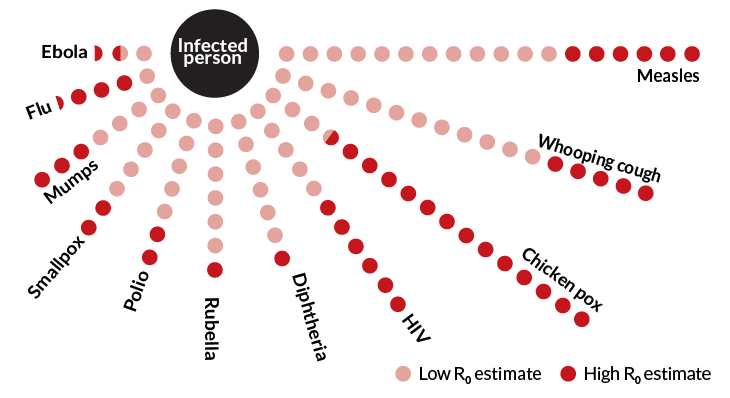By the numbers: How infectious measles and other diseases spread
An R0 is one measure of how easily a disease can spread

Measles is extremely contagious. And one number, or rather a range of them, sums up the risk of its spread.
SOLIDCOLOURS/ISTOCK/GETTY IMAGES PLUS
Two diseases have dominated headlines in the past few months. Measles sickened at least 1,044 people in the United States between January 1 and June 13. The virus has shown up in 26 U.S. states. And in the African country of Congo, Ebola has racked up 2,084 cases since August 2018. Of those, 1,405 people have died. This outbreak has also spilled over into neighboring Uganda.
Those numbers are scary. But another number illustrates how contagious a disease is. Really, it’s a range of numbers. It’s called the basic reproduction number, or R0 (pronounced “R naught”). This ratio describes how easily an infectious disease can spread.
Revealing ratio
Every infectious disease has a basic reproduction number, or R0. This is the average number of people who would catch the bug from one infected person, in a population where no one is immune to the disease.
Each dot in this graphic represents a person who would catch the disease from an infected person. R0 is usually expressed as a range because the factors that go into this ratio vary depending on the time and place of an outbreak.

If one person is sick in an unvaccinated population, R0 estimates how many others that person would infect, on average. Researchers can use R0 to estimate how big an outbreak may become. They also would use it to plan a response if terrorists had found some way to turn a disease into a weapon.
Every infectious event or outbreak has an R0. Three main variables go into calculating it. The first is how long people stay contagious once they’re infected (the number of days, for example). The second is how often an infected person is likely to come into contact with others on a daily basis. And the third variable is the likelihood of infecting those people. In turn, those variables are influenced by other factors. Those include the local environment and the average age of infected people. An R0 also can be affected by how closely people live to each other and things such as what public-health resources are available to them.
Killer calculations
Within epidemics, R0 can vary from country to country. If there’s more than one way to catch a certain disease, R0 also can vary between the transmission routes. That’s why when scientists talk about the R0 for a disease, they’re usually talking about a range of numbers.
For measles, that range is 12 to 18: One person is likely to sicken 12 to 18 others. That’s high compared to something like Ebola. There, one person may infect another 1.5 to 2.5 people.
That might seem surprising when you consider how many people Ebola has killed. But R0 measures how contagious something is, not how deadly it is.
Part of what affects this R0 is how a disease spreads between people. Measles can travel through the air. Ebola instead spreads through bodily fluids. So the odds of making contact with the Ebola virus is far lower.
David Smith is an epidemiologist, or disease detective, at the University of Washington in Seattle. “With measles,” he explains, “if you’re anywhere near someone with the disease, you could get it.” That’s why getting the measles vaccine is so important.
Researchers also can use the R0 to figure out what share of people needs to be vaccinated to prevent a disease from spreading. This is known as herd immunity.
For measles, generally 92 to 95 percent of a population needs to be vaccinated to reach herd immunity. Because Ebola has a lower R0 range, it also has a lower herd immunity threshold. Estimates suggest that only 42 to 63 percent of a population would need to be vaccinated to reach herd immunity against Ebola. Current vaccines are not 100 percent effective against all of Ebola’s various strains. Because of this, some researchers argue that the threshold may actually be higher — and that current vaccination efforts won’t get us there.
The R0 range is not perfect. Researchers described its flaws in the January 2019 Emerging Infectious Diseases. For one thing, people don’t always define R0 in the same way. So even researchers may misinterpret what it means. And R0 can’t tell you how well a vaccine or other control is working while an outbreak is underway. For that you’d need to look at another reproduction number, called R effective or Rt. This number changes during an outbreak.
Using R0 to describe an epidemic “isn’t great,” Smith acknowledges. The number assumes everyone’s immune system is encountering the disease for the first time and there are no vaccines. In an epidemic, that’s rarely true.
Measles’ high R0 shows why it’s good that there’s a vaccine. Before one became widely available in the 1960s, millions of people got the measles each year — and hundreds of them died.







